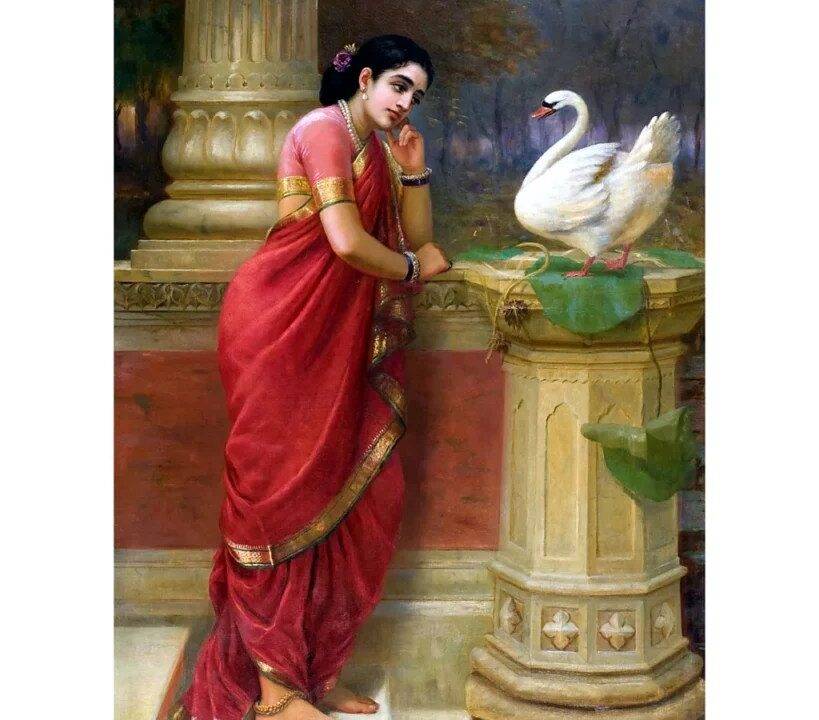Raja Ravi Varma and his paintings carry the essence of European technicalities and Indian sensibilities. Dive into the world of his work.
By Aryaa Anand

The one whose paintings’ lithographs adorn the homes of most Indians (especially South Indians), the prints of whose paintings formed a major part of the puja room decor, the one whose works influenced the largest-selling comic series book of India – Amar Chitra Katha; the legendary iconic artist Raja Ravi Varma. Born in the mid-nineteenth century (02 April 1848) in Kilimanoor, Travancore (present-day Thiruvananthapuram, Kerala), Raja Ravi Varma was a royal descendant of an aristocratic family in Travancore. The title ‘Raja’ was conferred upon him by Lord Curzon – the Viceroy and Governor-General of India.

He was one of the pioneers of fusion paintings. His style was to blend the technicalities and aesthetics of European paintings with the emotional sensibility, iconography and storytelling of Indian art. He made consistent and considerable efforts to revolutionise the vision Indian folk carried of the Gods and Goddesses. Earlier the picturisation of mythological characters and deities was more inclined towards their supernatural form. Raja Ravi Varma gave them a touch of human style. He focussed on the detailing of intricate designs of everything from fabrics and jewellery to furniture and artefacts. His paintings narrated stories, characters spoke of the social order and general social practices and backdrops radiated moods.
The next Maharaja of Travancore, Ayilyam Thirunal patronised Varma and he began his formal training thereafter. He was skilled in oil and water painting. He received his first commission painting in the year 1870 and the task was to paint a family portrait of the sub-judge of the Calicut Court – Kizakke Palat Krishnan Menon. Popularity and fame knocked at his door after an exhibition of his paintings in Vienna in 1873 fetched him an award.
Most of Raja Ravi Varma’s paintings revolved around the stories of Shakuntala and Dushyanta and Nala and Damayanti from the great Indian epic The Mahabharata. His paintings were also depictions of India’s folklore, ballads and stories from The Puranas. It is noteworthy that he received one of his most serious commissions from the Gaekwad of Baroda in the year 1888.
The commission involved making fourteen Puranic paintings for the Durbar Hall of the new Lakshmi Vilas Palace, Baroda. This required immense authenticity and a spectacular Indian touch in his representation of the mythological deities and characters. With assistance from his sister Mangalabai Thampuratty and younger artist brother C Raja Raja Varma, he successfully crafted fourteen illustrations; all of them masterpieces depicting either Lord Krishna’s adventures from The Bhagavata Purana or stories from The Mahabharata or The Ramayana.

Raja Ravi Varma was an artist who would consciously select themes, genres and mediums for his paintings. He would let the Western influence prevail but at the same time take care that it did not dominate his canvas; always keeping alive the spirit of Indian-ness in his work. Women, their ordeals, their beauty and their ornaments always held a special charm in Varma’s paintings. Women in traditional attire, women reclining in bed or women lost in thought formed a major part of his subjects. His brush strokes would paint costumes and pieces of jewellery with so much precision that they would look just like the original ones.

He was the first Indian artist to popularise calendar art. In 1894, he also set up a press called the Ravi Varma Fine Arts Lithographic Press in Lonavala. This came as a revolutionary move in the historical and social sphere of India as the press put to use imported German machines and techniques. Lithographs started trending among the Indian people. Art could now be ‘owned’ by anyone; people started fetching more and more reproductions of paintings from the Indian markets.
Raja Ravi Varma also brought to India certain significant international relations and accolades. He was honoured with an invitation to the World’s Columbian Exhibition at Chicago in 1893 where he showcased ten of his paintings. He was also in close relation with the German painter Fritz Schleicher who was the technical lead of the Raja Ravi Varma Fine Arts Press. Even when he became the owner of the press in 1903, he continued to spread the paintings of Raja Ravi Varma to the world.
Postcards also had imprints of Varma’s imageries. They were incorporated in advertisements, matchbox labels, textile prints and a whole lot of general everyday items found in Indian households. His work introduced fine arts to the general public of India. It made art accessible to everyone. Even after Raja Ravi Varma’s sad demise in 1906, his paintings went on to challenge perceptions and emerge as changemakers in the early twentieth-century society of India.
Many of his paintings form a part of the preserved collections of his works in the Lakshmi Vilas Palace, Baroda. His legacy continues to inspire generations of young artists and thinkers. His paintings transcend far beyond time and age.
Credits – Aryaa Anand – The Talented India

